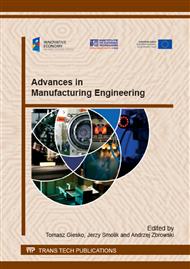[1]
R. Dindorf, Flexible pneumatic actuators, Monograph M55, Kielce University of Technology, Kielce, Poland, 2013 (in Polish).
Google Scholar
[2]
Cz. Kundera, Seals of rotating systems, Monograph M53, Kielce University of Technology, Kielce, Poland, 2013 (in Polish).
Google Scholar
[3]
A. Zbrowski, K. Jankowski, Test roztłaczania w kontroli jakości tulei polimerowych, Zeszyty Naukowe Politechniki Rzeszowskiej 288, Mechanika 85. t. XXX. z. 85 (1/13), str. 79-88, styczeń-marzec (2013).
DOI: 10.7862/rm.2013.8
Google Scholar
[4]
Cz. Kundera, T. Kozior, Research of the Elastic Properties of Bellows Made in SLS Technology, Advanced Materials Research, Vol. 874, pp.77-81, (2014).
DOI: 10.4028/www.scientific.net/amr.874.77
Google Scholar
[5]
R. Pacurar, P. Berce.: Research on the durability of injection molding tools made by selective laser sintering technology, Proceedings of the Romanian academy, Vol. 14, pp.234-241, (2013).
Google Scholar
[6]
G.V. Salmoria, J.L. Leite, L.F. Veira, A.T.N. Pires, C.R.M. Roesler.: Mechanical properties of PA6/PA12 blend specimens prepared by selective laser sintering, Polymer Testing 31, 411-416, (2012).
DOI: 10.1016/j.polymertesting.2011.12.006
Google Scholar
[7]
G.V. Salmoria, J.L. Leite, R.A. Paggi, A. Lago, A.T.N. Pires.: Selective laser sintering of PA 12/HDPE blends: Effect of components on elastic/plastic behavior, Polymer Testing 27, 654-659, (2008).
DOI: 10.1016/j.polymertesting.2008.04.007
Google Scholar
[8]
G.V. Salmoria, J.L. Leite, R.A. Paggi, C. H. Arhens, A. S. Pouzada.: Microstructural characterization and mechanical properties of functionally graded PA12/HDPE parts by selective laser sintering, Journal of Advanced Manufacturing Technology, Vol. 59, p.583, (2012).
DOI: 10.1007/s00170-011-3538-5
Google Scholar
[9]
A. Pilipović, B. Valentan, T. Brajlih, T. Haramina, J. Balic, J. Kodvanj, M. Sercer, I. Drstvensek.: Influence of Laser Sintering Parameters on Mechanical Properties of Polymer Product. International Conference on Additive Technologies, Nova Gorica, Slovenia (2010).
Google Scholar
[10]
M Schmid, C Simon, G.N. Levy.: Finishing of SLS-parts for rapid manufacturing (RM)-a comprehensive approach, International Solid Freeform Fabrication Symposium, Austin (TX), USA (2009).
Google Scholar
[11]
Formiga P100, User Manual EOS, Munich, (2008).
Google Scholar
[12]
M Vable.: Mechanics of materials. Oxford University Press. New York, (2008).
Google Scholar
[13]
Information on http: /www. solidworks. com.
Google Scholar


